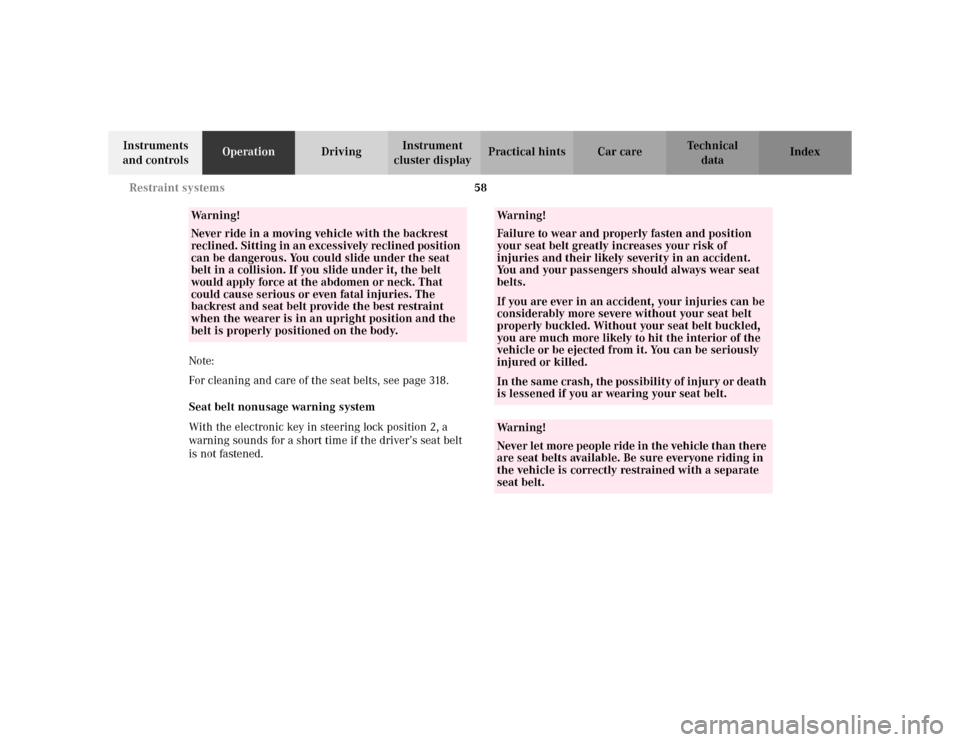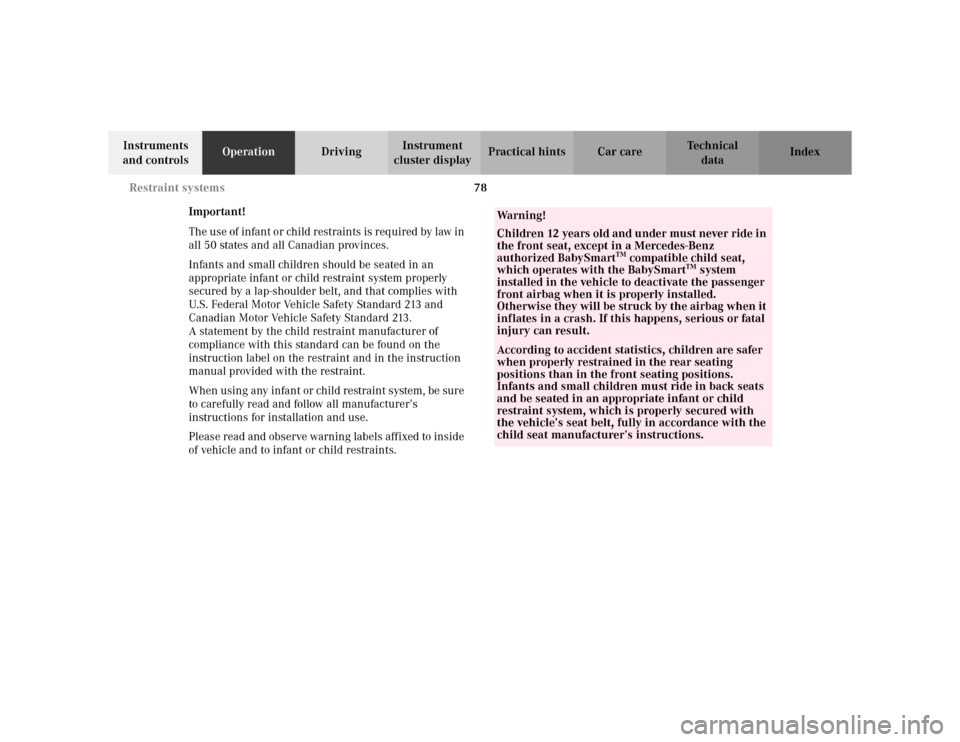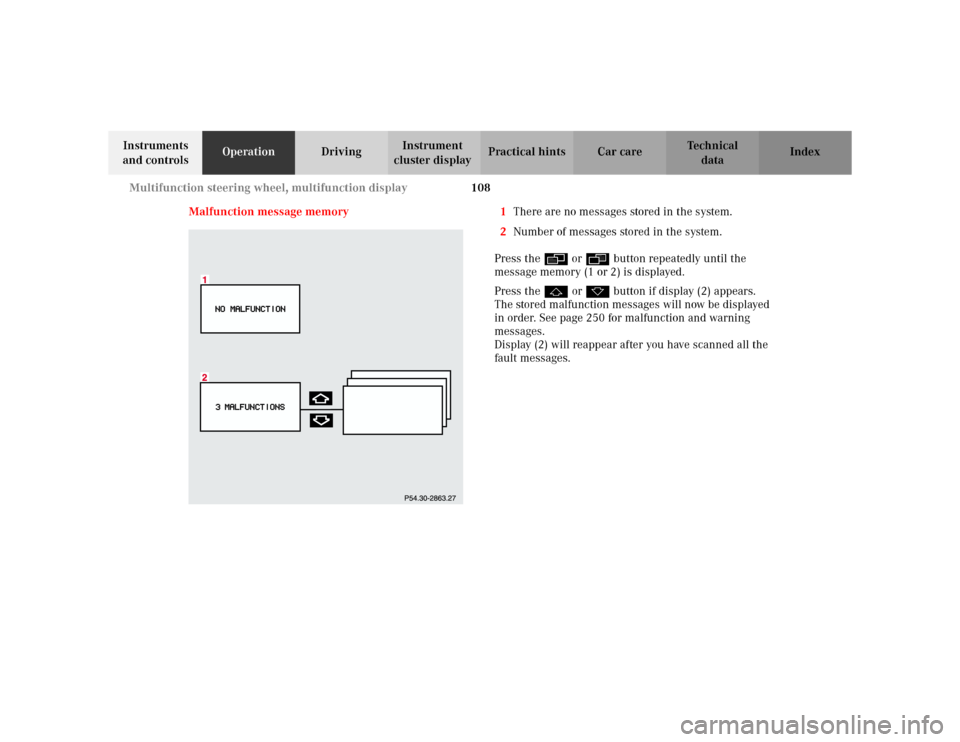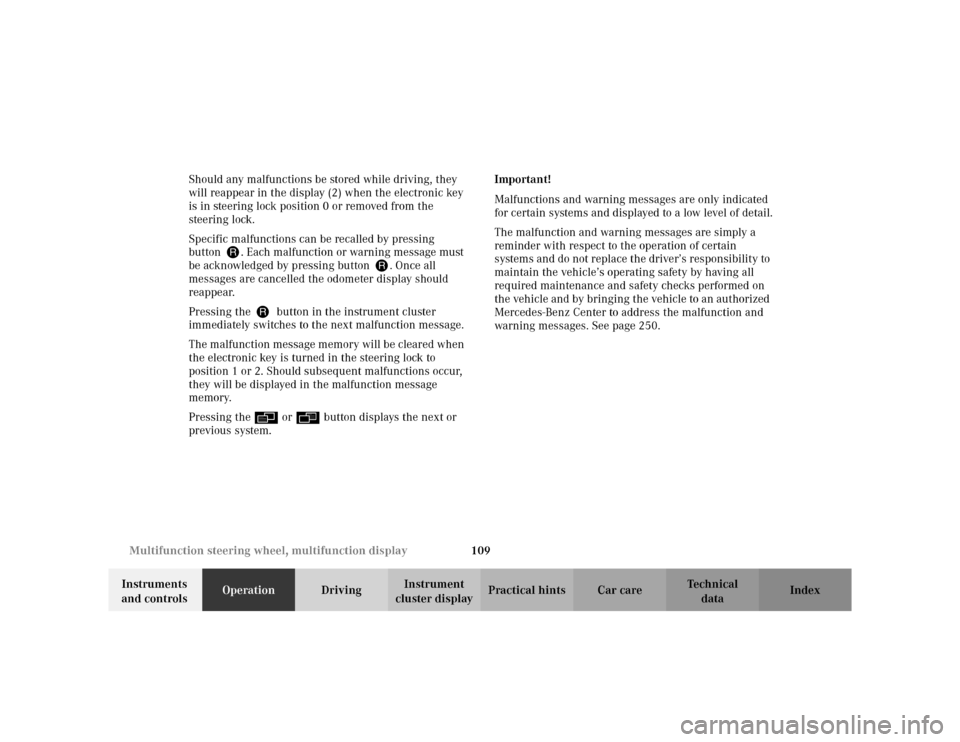2002 MERCEDES-BENZ E WAGON warning
[x] Cancel search: warningPage 25 of 354

22 Contents – Operation
Te ch n i c a l
data Instruments
and controlsOperationDrivingInstrument
cluster displayPractical hints Car care Index
OperationVehicle keys ...................................... 24
Start lock-out .................................... 26
General notes on the
central locking system ............... 26
Central locking system ................... 27
Radio frequency and
infrared remote control ............... 27
Opening and closing windows
and sliding/pop-up roof
from outside .................................. 30
Panic button .................................. 31
Mechanical keys ........................... 31
Doors .................................................. 32
Central locking switch .................... 34
Automatic central locking .............. 35
Emergency unlocking
in case of accident ...................... 35
Tailgate .............................................. 36
Antitheft alarm system ................... 39
Tow-away alarm ................................ 41
Power seats front ............................. 42
Front seat head restraints .............. 48Rear seat head restraints ............... 49
Multicontour seat .............................51
Seat heater ........................................ 52
Seat ventilation ................................ 55
Seat belts and
integrated restraint system ....... 57
Seat belts .......................................... 57
Seat belt nonusage
warning system .......................... 58
BabySmart
TM airbag
deactivation system ................... 65
Self-test BabySmart
TM without
special child seat installed ......... 65
Supplemental restraint system
(SRS) ............................................. 66
Emergency tensioning retractor
(ETR) ............................................. 67
Airbags .............................................. 68
Safety guidelines for the seat belt,
emergency tensioning retractor
and airbag .................................... 75
Infant and child
restraint systems ........................ 77
Steering wheel adjustment .............81
Rear view mirrors ........................... 82Instrument cluster ........................... 86
Multifunction steering wheel,
multifunction display ................. 92
Trip and main odometer, FSS
and engine oil level display ....... 96
Audio systems .................................. 97
Radio .............................................. 97
CD player ....................................... 98
Cassette player ............................. 99
Telephone ........................................ 100
Telephone book .......................... 100
Redialing ..................................... 102
Incoming call .............................. 104
Navigation system .......................... 105
Trip computer ................................. 106
Malfunction message memory .... 108
Individual settings ..........................110
Setting the audio volume ..............113
Flexible service system (FSS) .......114
Engine oil level indicator ...............117
Engine oil consumption .................118
Exterior lamp switch ......................119
Night security Illumination ......... 120
Headlamp cleaning system .......... 121
Page 26 of 354

23 Contents – Operation
Te ch n i c a l
data Instruments
and controlsOperationDrivingInstrument
cluster displayPractical hints Car care Index Combination switch ...................... 122
Rear window wiper / washer ....... 124
Hazard warning
flasher switch ............................ 125
Automatic climate control ............ 126
Display and controls .................. 128
Basic setting ................................ 129
Special settings .......................... 129
Defogging windows .................... 129
Defrosting .................................... 129
Rear window defroster .............. 130
Air distribution ........................... 130
Air volume ................................... 130
Air recirculation ......................... 131
Dust filter .................................... 131
Activated charcoal filter ............ 132
Residual engine
heat utilization ........................... 132Front center console
compartment ventilation ...........133
Rear passenger compartment
adjustable air outlet ...................134
Audio and telephone,
operation .....................................135
Power windows ...............................154
Sliding / pop-up roof ......................157
Interior lighting ..............................159
Entrance lamps,
exit lamps in doors ....................159
Reading lamps
rear compartment ......................160
Sun visors ........................................ 161
Illuminated vanity mirrors ........... 161
Interior .............................................162
Armrest, rear bench .......................162
Cup holder
in rear bench armrest ...............162Glove box ......................................... 163
Cup holder and coin holder
in glove box lid ........................... 163
Storage compartment above
ashtray in center console ........ 164
Storage compartments
in center console ....................... 164
Cup holder in center console ....... 165
Ashtrays .......................................... 166
Lighter ............................................. 168
Split rear bench seat ..................... 169
Rear-facing bench seat .................. 175
Loading instructions ..................... 177
Cargo tie-down rings ..................... 178
Parcel net
in front passenger footwell ..... 179
Cellular telephone ......................... 179
Garage door opener ....................... 180
Page 61 of 354

58 Restraint systems
Te ch n i c a l
data Instruments
and controlsOperationDrivingInstrument
cluster displayPractical hints Car care Index
Note:
For cleaning and care of the seat belts, see page 318.
Seat belt nonusage warning system
With the electronic key in steering lock position 2, a
warning sounds for a short time if the driver’s seat belt
is not fastened.
Wa r n i n g !
Never ride in a moving vehicle with the backrest
reclined. Sitting in an excessively reclined position
can be dangerous. You could slide under the seat
belt in a collision. If you slide under it, the belt
would apply force at the abdomen or neck. That
could cause serious or even fatal injuries. The
backrest and seat belt provide the best restraint
when the wearer is in an upright position and the
belt is properly positioned on the body.
Wa r n i n g !
Failure to wear and properly fasten and position
your seat belt greatly increases your risk of
injuries and their likely severity in an accident.
You and your passengers should always wear seat
belts.If you are ever in an accident, your injuries can be
considerably more severe without your seat belt
properly buckled. Without your seat belt buckled,
you are much more likely to hit the interior of the
vehicle or be ejected from it. You can be seriously
injured or killed.In the same crash, the possibility of injury or death
is lessened if you ar wearing your seat belt.Wa r n i n g !
Never let more people ride in the vehicle than there
are seat belts available. Be sure everyone riding in
the vehicle is correctly restrained with a separate
seat belt.
Page 81 of 354

78 Restraint systems
Te ch n i c a l
data Instruments
and controlsOperationDrivingInstrument
cluster displayPractical hints Car care Index
Important!
The use of infant or child restraints is required by law in
all 50 states and all Canadian provinces.
Infants and small children should be seated in an
appropriate infant or child restraint system properly
secured by a lap-shoulder belt, and that complies with
U.S. Federal Motor Vehicle Safety Standard 213 and
Canadian Motor Vehicle Safety Standard 213.
A statement by the child restraint manufacturer of
compliance with this standard can be found on the
instruction label on the restraint and in the instruction
manual provided with the restraint.
When using any infant or child restraint system, be sure
to carefully read and follow all manufacturer’s
instructions for installation and use.
Please read and observe warning labels affixed to inside
of vehicle and to infant or child restraints.
Wa r n i n g !
Children 12 years old and under must never ride in
the front seat, except in a Mercedes-Benz
authorized BabySmart
TM compatible child seat,
which operates with the BabySmart
TM system
installed in the vehicle to deactivate the passenger
front airbag when it is properly installed.
Otherwise they will be struck by the airbag when it
inflates in a crash. If this happens, serious or fatal
injury can result.
According to accident statistics, children are safer
when properly restrained in the rear seating
positions than in the front seating positions.
Infants and small children must ride in back seats
and be seated in an appropriate infant or child
restraint system, which is properly secured with
the vehicle’s seat belt, fully in accordance with the
child seat manufacturer’s instructions.
Page 90 of 354

87 Instrument cluster
Te ch n i c a l
data Instruments
and controlsOperationDrivingInstrument
cluster displayPractical hints Car care Index 1Push buttons for intensity of instrument lamps,
seepage89
2Push button for resetting trip odometer, see page 91,
or to acknowledge a malfunction or warning
message, see page 108
3Coolant temperature gauge, see page 90
4Fuel gauge with reserve and fuel cap placement
warning lamp, see page 246
5Outside temperature indicator, see page 90
6Left turn signal indicator lamp, see combination
switch on page 122
7Electronic stability program (ESP) warning lamp,
see page 2478Speedometer
9Trip odometer, see page 91 and 96
10Main odometer, see page 96
11Multifunction display, see page 92,
or FSS indicator, see page 114,
or engine oil level indicator, see page 117
12Right turn signal indicator lamp, see combination
switch on page 122
13Tachometer, see page 91
14Gear range indicator display, see page 206
15Clock
To set the time, see page 110
Page 93 of 354

90 Instrument cluster
Te ch n i c a l
data Instruments
and controlsOperationDrivingInstrument
cluster displayPractical hints Car care Index
Coolant temperature gauge (3)
During severe operating conditions and stop-and-go city
traffic, the coolant temperature may rise close to the red
marking.
The engine should not be operated with the coolant
temperature in the red zone. Doing so may cause
serious engine damage which is not covered by the
Mercedes-Benz Limited Warranty.Outside temperature indicator (5)
The temperature sensor is located in the front bumper
area. Due to its location, the sensor can be affected by
road or engine heat during idling or slow driving. This
means that the accuracy of the displayed temperature
can only be verified by comparison to a thermometer
placed next to the sensor, not by comparison to external
displays (e.g. bank signs etc.).
Adaption to ambient temperature takes place in steps
and depends on the prevailing driving conditions
(stop-and-go or moderate, constant driving) and amount
of temperature change.
Wa r n i n g !
• Driving when your engine is badly overheated
can cause some fluids which may have leaked
into the engine compartment to catch fire. You
could be seriously burned.• Steam from an overheated engine can cause
serious burns and can occur just by opening
the engine hood. Stay away from the engine if
you see or hear steam coming from it.Turn off the engine, get out of the vehicle and do
not stand near the vehicle until it cools down.
Wa r n i n g !
The outside temperature indicator is not designed
to serve as an Ice-Warning Device and is therefore
unsuitable for that purpose. Indicated
temperatures just above the freezing point do not
guarantee that the road surface is free of ice.
Page 111 of 354

108 Multifunction steering wheel, multifunction display
Te ch n i c a l
data Instruments
and controlsOperationDrivingInstrument
cluster displayPractical hints Car care Index
Malfunction message memory 1There are no messages stored in the system.
2Number of messages stored in the system.
Press the è or ÿ button repeatedly until the
message memory (1 or 2) is displayed.
Press the j or k button if display (2) appears.
The stored malfunction messages will now be displayed
in order. See page 250 for malfunction and warning
messages.
Display (2) will reappear after you have scanned all the
fault messages.
Page 112 of 354

109 Multifunction steering wheel, multifunction display
Te ch n i c a l
data Instruments
and controlsOperationDrivingInstrument
cluster displayPractical hints Car care Index Should any malfunctions be stored while driving, they
will reappear in the display (2) when the electronic key
is in steering lock position 0 or removed from the
steering lock.
Specific malfunctions can be recalled by pressing
buttonJ. Each malfunction or warning message must
be acknowledged by pressing buttonJ. Once all
messages are cancelled the odometer display should
reappear.
Pressing theJbutton in the instrument cluster
immediately switches to the next malfunction message.
The malfunction message memory will be cleared when
the electronic key is turned in the steering lock to
position 1 or 2. Should subsequent malfunctions occur,
they will be displayed in the malfunction message
memory.
Pressing the è or ÿ button displays the next or
previous system.Important!
Malfunctions and warning messages are only indicated
for certain systems and displayed to a low level of detail.
The malfunction and warning messages are simply a
reminder with respect to the operation of certain
systems and do not replace the driver’s responsibility to
maintain the vehicle’s operating safety by having all
required maintenance and safety checks performed on
the vehicle and by bringing the vehicle to an authorized
Mercedes-Benz Center to address the malfunction and
warning messages. See page 250.